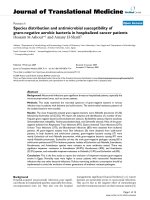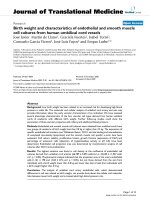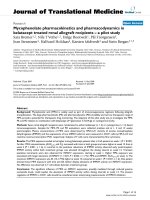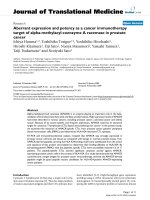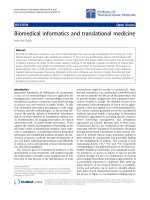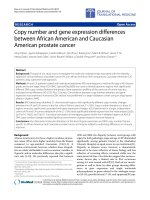Báo cáo hóa học: " Hydrothermal Growth and Application of ZnO Nanowire Films with ZnO and TiO2 Buffer Layers in Dye-Sensitized Solar Cells" docx
Bạn đang xem bản rút gọn của tài liệu. Xem và tải ngay bản đầy đủ của tài liệu tại đây (518.28 KB, 7 trang )
NANO EXPRESS
Hydrothermal Growth and Application of ZnO Nanowire Films
with ZnO and TiO
2
Buffer Layers in Dye-Sensitized Solar Cells
Weiguang Yang Æ Farong Wan Æ Siwei Chen Æ
Chunhua Jiang
Received: 26 April 2009 / Accepted: 18 August 2009 / Published online: 16 September 2009
Ó to the authors 2009
Abstract This paper reports the effects of the seed layers
prepared by spin-coating and dip-coating methods on the
morphology and density of ZnO nanowire arrays, thus on
the performance of ZnO nanowire-based dye-sensitized
solar cells (DSSCs). The nanowire films with the thick ZnO
buffer layer (*0.8–1 lm thick) can improve the open
circuit voltage of the DSSCs through suppressing carrier
recombination, however, and cause the decrease of dye
loading absorbed on ZnO nanowires. In order to further
investigate the effect of TiO
2
buffer layer on the perfor-
mance of ZnO nanowire-based DSSCs, compared with the
ZnO nanowire-based DSSCs without a compact TiO
2
buffer layer, the photovoltaic conversion efficiency and
open circuit voltage of the ZnO DSSCs with the compact
TiO
2
layer (*50 nm thick) were improved by 3.9–12.5
and 2.4–41.7%, respectively. This can be attributed to the
introduction of the compact TiO
2
layer prepared by sput-
tering method, which effectively suppressed carrier
recombination occurring across both the film–electrolyte
interface and the substrate–electrolyte interface.
Keywords ZnO nanowires Á Arrays Á DSSC Á
Hydrothermal growth
Introduction
Dye-sensitized solar cells (DSSCs) based on a dye-sensi-
tized wide-band-gap nanocrystalline semiconductor (typi-
cally TiO
2
) film have attracted widespread attention as a
potential, cost-effective alternative to silicon solar cells
since they were first introduced by O’Regan and Gra
¨
tzel in
1991 [1]. As one of the key components of dye-sensitized
solar cells, the photoelectrode, composed of nanocrystal-
line semiconductor materials accumulated on a transparent
conducting glass, has a very important influence on the
photovoltaic performance [2, 3]. It is well known that
the energy conversion efficiency of DSSCs depends on the
electron transport in the photoelectrode. Therefore, one-
dimensional structure such as rods or wires of semicon-
ductor materials can greatly improve DSSCs efficiency by
offering direct electrical pathways for photogenerated
electrons, thus enhancing the electron transport in the
photoelectrode. Recently, considerable efforts have been
devoted to the synthesis of such 1D materials used as the
photoelectrodes of DSSCs [4–7].
Among various emerging 1D nanomaterials, ZnO, a
wide-band-gap (3.37 eV) semiconductor with a large
exciton binding energy of 60 meV at room temperature, is
a promising alternative semiconductor to TiO
2
.Thisis
because that the band gap and the energetic position of the
valence band maximum and conduction band minimum of
ZnO are very close to that of TiO
2
and that the wurtzite
structure of ZnO favors the formation of ordered 1D
structures, moreover, presenting better electron transport
compared with TiO
2
[4]. Consequently, the solar cell using
W. Yang Á F. Wan (&) Á S. Chen
Department of Materials Physics and Chemistry, University
of Science and Technology Beijing, 100083 Beijing, China
e-mail:
W. Yang
e-mail:
F. Wan
Beijing Key Lab of Advanced Energy Material and Technology,
100083 Beijing, China
C. Jiang
State Approved Technology Center, Irico Group Corp, 100085
Beijing, China
123
Nanoscale Res Lett (2009) 4:1486–1492
DOI 10.1007/s11671-009-9425-4
nanowire arrays as the photoelectrodes shows a higher
conversion efficiency compared to those using the disor-
deredly structured ZnO films [4]. In order to further
improve the cell efficiency, the effective approaches cur-
rently applied are to control the morphology of ZnO
nanostructure films, which can significantly increase dye
loading and light harvesting [8, 9], and to modify the
surface of ZnO nanostructure films that can suppress carrier
recombination [10]. However, by introducing a blocking
layer at the base of the ZnO films, the influence of the
blocking layer on the performance of ZnO DSSCs is an
ongoing debate [10].
In this study, we report that the ZnO nanowire films with
high aspect ratios and different thicknesses of ZnO buffer
layers, which formed at the base of the nanowire films
during growth, were prepared from different ZnO seed
preparation methods. We also show that carrier recombi-
nation in ZnO nanowire-based dye-sensitized solar cells
can be effectively suppressed and the photovoltaic con-
version efficiency enhanced by introducing the TiO
2
buffer
layer prepared by sputtering method.
Experimental Section
Materials
Polyethyleneimine (PEI, M.W.: 600) was purchased from
Aldrich and used as received. Cis-bis (isothiocyanato) bis
(2,2
0
-bipyridy1-4,4
0
-dicarboxylate) ruthenium (II) bistetra-
butylammonium (also called N719) was from Solaronix
SA, Switzerland. Other chemicals (Beijing Chemical Co.)
used in our experiments were of analytical reagent grade
without further purification. Fluorine-doped tin oxide sub-
strates (FTO TEC-8, LOF) were first cleaned through
sonication in acetone/ethanol for 30 min and then hydro-
lyzed in boiling deionized water at 100 °C for 30 min
followed by air-drying.
ZnO Nanowire Array Synthesis
ZnO nanowire arrays were made in aqueous solution, using a
two-step process described elsewhere [4]. To study the effect
of a thin compact TiO
2
film on FTO substrate on the solar cell
performance of ZnO array film, it was prepared at room
temperature by using reactive DC magnetron sputtering.
Preparation of ZnO Seeds on FTO Substrates
In order to study the effect of ZnO crystal seed particles on
the morphology and solar cell performance of ZnO array
film, they were coated onto the FTO substrates by using
two different methods.
1. Spin-coating method. Zinc acetate dehydrate
[Zn(CH
3
COO)
2
Á2H
2
O] was dissolved in the mixed
solution of ethanolamine and 2-methoxyethanol. The
concentrations of both Zn(CH
3
COO)
2
Á2H
2
O and eth-
anolamine in the resulting solution are 0.75 M. The
coating solution was spin-coated onto FTO substrates
at 3,000 rpm for several times. The FTO substrates
were subsequently annealed at 300 °C in air for
15 min in order to convert Zinc acetate to ZnO.
2. Dip-coating method. The FTO substrates were dip-
coated in a 2.5 mM ethanolic solution of zinc acetate
dehydrate. Following dip-coating, the zinc acetate
films on the FTO substrates were annealed at 300 °Cin
air for 15 min.
Hydrothermal Deposition
ZnO nanowire arrays were grown by placing vertically the
ZnO-seeded FTO substrates in solutions with 25 mM
Zn(NO
3
)
2
, 25 mM hexamethylenetetramine (HMT) and
7.3 mM polyethyleneimine at 92.5 °C. In order to obtain a
constant nanowire array growth rate, the solutions were
refreshed during the reaction period (solution turnover time
2.5 h). Subsequently, the substrates were washed with
water/ethanol and annealed at 400 °C for 30 min to remove
any residual organics.
Cell Assembly
The resulting substrates were immersed in dry ethanol
containing 0.3 mM of N719 for 40 min. To assemble the
solar cells, a Pt-coated conducting glass was placed on the
ZnO nanowire array films separated by a 50-lm thin
membrane spacer. The assembled cell was then clipped
together as an open cell. An electrolyte, which was made
with 0.1 M LiI (Aldrich), 0.1 M I
2
(Aldrich), 0.6 M
dimethylpropylimidazolium iodide (DMPImI, Aldrich) and
0.5 M tert-butylpyridine (Aldrich) in dry acetonitrile
(Aldrich), was injected into the open cell from the edges by
capillarity.
Characterization
The morphology of the products was characterized with
use of field-emission scanning electron microscopy (FE-
SEM, Hitachi S-4800). XRD analysis was performed on a
powder X-ray diffractometer (Rigaku D/max-2500 dif-
fractometer using CuKa radiation, k = 0.1542, 40 kV,
100 mA). Photocurrent–voltage measurements were per-
formed using simulated AM 1.5 sunlight with an output
power of 100 mW cm
-2
.
Nanoscale Res Lett (2009) 4:1486–1492 1487
123
Results and Discussion
Effect of ZnO Crystal Seed Particles Prepared
by Different Methods
In this study, we found that the different ZnO seed prep-
aration methods strongly influenced the morphology and
density of ZnO nanowire arrays, leading to the different
performance of the DSSCs based on the ZnO nanowire
films. Figure 1 shows the top-view and cross-sectional
FESEM images of two samples prepared with 7.3 mM of
PEI for 30 h on the FTO substrates with ZnO seed layers
prepared by spin-coating and dip-coating. The mean values
of the nanowire dimension, the array density and aspect
ratio were estimated from a statistical evaluation of FE-
SEM images and are summarized in Table 1. In order to
avoid possible variations at their top, the diameters of the
nanowires were measured slightly below the nanowire tip.
Although they had the similar length, the diameter distri-
butions between the well-aligned ZnO nanowires for
samples A and B had a significant difference. The nanowire
arrays for the samples A1, A2 and A3 had mean diameters
ranging from 195 to 210 and 120 to 150 nm for samples
B1, B2 and B3. The densities of ZnO nanowires for sam-
ples A1, A2 and A3 were 2.1, 2.2 and 2.0 9 10
9
wir-
es cm
-2
, respectively, which are much higher than that of
samples B1, B2 and B3 (1.5, 1.6, 1.2 9 10
9
wires cm
-2
).
The different thicknesses of ZnO buffer layers, which
formed at the base of the nanowire films during growth,
were obtained from different preparation ZnO seed meth-
ods: *0.8–1 lm for samples A1, A2 and A3; *300–
500 nm for samples B1, B2 and B3. From the resulting
observations, we can conclude that the high density of the
nanowires achieved is attributed to the larger number of
ZnO seeds on the FTO surface prepared by several spin-
coating times [11, 12], and that, however, this seed prep-
aration method results in a greater variation in nanowire
diameter. The crystallinity of grown ZnO nanowire arrays
on FTO substrate was investigated using X-ray diffraction.
Because all the samples had the very similar XRD patterns,
only the XRD pattern of sample B1 was shown in Fig. 2.
Diffraction peaks in XRD pattern can be indexed as
wurtzite hexagonal structure (JCPDS card No. 36-1451).
With respect to the crystallographic orientation, the most
Fig. 1 SEM images of ZnO
nanowire arrays grown on FTO
substrates with different ZnO
seed obtained from (a–f) the
spin-coating method, (g–k) the
dip-coating method. a, c, e, g, i
and k correspond to top-view
observations, b, d, f, h, j and l
correspond to cross-sectional
views. The insets show high-
magnification SEM images
1488 Nanoscale Res Lett (2009) 4:1486–1492
123
intense peak of ZnO corresponds to the (0002) plane,
indicating a strong preferential orientation along the (0001)
direction. The resulting observation can be inferred from
SEM observations (Fig. 1b, d, f, h, j and l). These results
reveal that the nanowires, crystallized along the ZnO
(0001) direction, were hexagonal prisms vertically aligned
on the FTO substrate.
The effect of the morphology and density of ZnO
nanowire arrays on their DSSC performance was investi-
gated, as shown in Fig. 3, while the parameters of dye-
sensitized solar cell based on ZnO nanowire array films are
listed in Table 2. Although the densities of nanowire arrays
for samples B1, B2 and B3 were lower than that of samples
A1, A2 and A3, the short circuit current density (I
sc
)
increased from 1.61–1.97 to 1.93–2.25 mA cm
-2
, and in
contrast, the open circuit voltage (V
oc
) decreased from
0.57–0.58 to 0.54–0.56 V on using samples B1, B2 and B3
as the photoanode compared with samples A1, A2 and A3.
The fill factor showed little change for all samples. The
samples B1, B2 and B3 based DSSCs demonstrated higher
energy conversion efficiency (g) of 0.66–0.73% when
compared to the samples A1, A2 and A3 based DSSCs of
0.57–0.69%. The increase in I
sc
may be due to that the ZnO
nanowires with the thin ZnO buffer layer (*300–500 nm)
had higher aspect ratios (*55–79) compared with that
(*39–48) of the ZnO nanowires with *0.8–1 lm of the
ZnO buffer layer, which caused the increase of dye loading
absorbed on ZnO nanowires [13]. However, the ZnO buffer
layer can act as a blocking layer to suppress carrier
recombination that can occur across both the film–
electrolyte interface and the substrate–electrolyte interface
Table 1 Mean values of the
nanowire dimensions, nanowire
aspect ratio and array density
for different ZnO seed
preparation methods
ZnO seed preparation
methods
Diameter
(nm)
Length
(lm)
Nanowire aspect
ratio
Density
(910
9
wires cm
-2
)
Spin-coating
Sample A1 200 9.5 48 2.1
Sample A2 195 9.1 47 2.2
Sample A3 210 8.2 39 2.0
Dip-coating
Sample B1 120 9.5 79 1.5
Sample B2 150 8.2 55 1.6
Sample B3 130 9.8 75 1.2
Fig. 2 XRD pattern of the sample B1
Fig. 3 Current–voltage plots for ZnO DSSCs based on nanowire
arrays prepared by different seed preparation methods
Table 2 Parameters of dye-sensitized solar cell based on ZnO
nanowire array films with different ZnO seed preparation methods
Sample I
sc
(mA/cm
2
) Voc (V)ff g (%)
Sample A1 1.97 0.58 0.60 0.69
Sample A2 1.87 0.57 0.60 0.64
Sample A3 1.61 0.58 0.61 0.57
Sample B1 2.25 0.54 0.59 0.72
Sample B2 1.93 0.56 0.61 0.66
Sample B3 2.14 0.54 0.63 0.73
Nanoscale Res Lett (2009) 4:1486–1492 1489
123
[10]. Therefore, the thin ZnO buffer layer can less effec-
tively suppress carrier recombination than the thick ZnO
buffer layer for sample A, resulting in the maximum loss of
V
oc
(*40 mV).
Effect of TiO
2
Blocking Layer
In this section, we investigated the influence of a dense, thin
TiO
2
blocking layer (about 50 nm thick, as can be seen from
Fig. 4h, j and l) underneath the ZnO nanowire array film
prepared by sputtering method on carrier recombination in
ZnO DSSC. Figure 4 shows the top-view and cross-sec-
tional FESEM images of ZnO nanowire arrays prepared with
7.3 mM of PEI for 40 h on the bare FTO substrate and on the
TiO
2
-coated FTO substrate with the ZnO seeds prepared by
dip-coating. The mean values of the nanowire dimension,
the array density and aspect ratio are summarized in Table 3.
As shown in Fig. 4, fairly well-aligned nanowires, typically
160–170 nm wide with the length of 10.6–11 lm, and 120–
135 nm wide with the length of 10.8–11.2 lm, grew onto
the bare and TiO
2
-coated FTO substrates, respectively. The
six ZnO nanowire films had a similar thickness of ZnO
buffer layer (*500 nm). The density of ZnO nanowires for
the bare FTO substrate were 1.4–1.6 9 10
9
wires cm
-2
,
which are slightly higher than that of the TiO
2
-coated FTO
substrate (1.1–1.5 9 10
9
wires cm
-2
).
The effect of the TiO
2
blocking layer on the photovoltaic
performance of a DSSC was investigated. The current–
voltage characteristics of the DSSCs for the bare and TiO
2
-
coated FTO substrates are shown in Fig. 5. The parameters
of the cells are summarized in Table 4. The DSSC derived
from the nanowire arrays with the TiO
2
blocking layer
exhibited considerably improved I
sc
and V
oc
, compared to
that of the DSSC without the TiO
2
blocking layer. However,
the change trend of the fill factor was complex. This is, I
sc
was increased by 4.2–25.1% from 3.31–3.77 to 3.72–
4.14 mA cm
-2
, and V
oc
was increased by 3.9–12.5% from
0.48–0.51 to 0.53–0.55 V. As a result, g was improved by
2.4–41.7% from 0.72–0.84 to 0.86–1.02% by introducing
the TiO
2
blocking layer. The increase in I
sc
can be attributed
to the increase in the aspect ratio of the nanowire arrays
with and without the TiO
2
blocking layer from about 65–67
Fig. 4 Top-view and cross-
sectional SEM images of ZnO
nanowire arrays prepared with
7.3 mM of PEI for 40 h a–f on
the bare FTO substrate and g–l
on the TiO
2
-coated FTO
substrate. The insets show high-
magnification SEM images
1490 Nanoscale Res Lett (2009) 4:1486–1492
123
to 80–93. V
oc
is known to be strongly dependent on the
charge recombination reactions taking place on both the
film–electrolyte interface and the substrate–electrolyte
interface, a larger V
oc
value can be achieved through sup-
pressing those reactions [14]. Therefore, the increase in V
oc
indicates that the compact TiO
2
layer prepared by sputtering
method can effectively suppress the charge recombination.
This clearly shows an effective increase in g by introducing
the TiO
2
blocking layer.
Conclusion
In summary, the work presented here shows that the dif-
ferent ZnO seed preparation methods strongly influenced
the morphology and density of ZnO nanowire arrays. The
nanowire film growing from the ZnO seeds prepared by dip-
coating had a thin ZnO buffer layer (*300–500 nm thick),
which can less effectively suppress carrier recombination
than the thick ZnO buffer layer (*0.8–1 lm thick) for spin-
coating, resulting in the maximum loss of V
oc
(about
40 mV). In order to further investigate the effect of a TiO
2
buffer layer on the performance of ZnO nanowire-based
DSSCs, a TiO
2
blocking layer (about 50 nm thick) under-
neath the ZnO nanowire array film was prepared onto the
FTO substrate by sputtering method. The two different ZnO
nanowire films with and without the compact TiO
2
buffer
layer (*50 nm) had the similar thickness of ZnO buffer
layer (*300–500 nm) and were used to assemble the
DSSCs. By introducing the compact TiO
2
layer (*50 nm
thick), the photovoltaic conversion efficiency and open
circuit voltage of the ZnO DSSCs were improved by 3.9–
12.5 and 2.4–41.7%, respectively. This can be because that
the compact TiO
2
layer effectively suppressed carrier
recombination occurring across both the film–electrolyte
interface and the substrate–electrolyte interface.
Acknowledgments The authors would like to acknowledge finan-
cial support for this work from the Beijing Municipal Education
Commission.
References
1. B. O’Regan, M. Gra
¨
tzel, Nature 353, 737 (1991)
2. M.K. Nazeeruddin, P. Pechy, T. Renouard, S.M. Zakeeruddin, R.
Humphry-Baker, P. Comte, P. Liska, L. Cevey, E. Costa, V.
Shklover, L. Spiccia, G.B. Deacon, C.A. Bignozzi, M. Gratzel, J.
Am. Chem. Soc. 123, 1613 (2001)
3. C.D. Grant, A.M. Schwartzberg, G.P. Smestad, J. Kowalik, L.
Tolbert, J.Z. Zhang, J. Electroanal. Chem. 522, 40 (2002)
4. M. Law, L.E. Greene, J.C. Johnson, R. Saykally, P.D. Yang, Nat.
Mater. 4, 455 (2005)
Table 3 Mean values of the
nanowire dimensions, nanowire
aspect ratio and array density
for nanowire arrays on the bare
and TiO
2
-coated FTO substrates
ZnO seed preparation
methods
Diameter
(nm)
Length
(lm)
Nanowire aspect
ratio
Density
(910
9
wires cm
-2
)
Bare FTO substrates
Sample C1 170 11 65 1.4
Sample C2 165 11 67 1.5
Sample C3 160 10.6 66 1.6
TiO
2
-coated FTO
Sample D1 130 11 85 1.1
Sample D2 120 11.2 93 1.2
Sample D3 135 10.8 80 1.5
Fig. 5 Current–voltage curves for ZnO DSSCs based on nanowire
arrays grown onto the bare and TiO
2
-coated FTO substrates
Table 4 Parameters of dye-sensitized solar cell based on ZnO
nanowire array films on the bare and TiO
2
-coated FTO substrates
Sample I
sc
(mA/cm
2
) Voc (V)ff g (%)
Sample C1 3.31 0.51 0.48 0.80
Sample C2 3.50 0.49 0.49 0.84
Sample C3 3.77 0.48 0.40 0.72
Sample D1 3.93 0.55 0.40 0.86
Sample D2 4.14 0.53 0.46 1.02
Sample D3 3.72 0.54 0.50 1.01
Nanoscale Res Lett (2009) 4:1486–1492 1491
123
5. S.H. Kang, S H. Chio, M S. Kang, J Y. Kim, H S. Kim, T.
Hyeon, Y E. Sung, Adv. Mater. 20, 54 (2008)
6. J.R. Jennings, A. Ghicov, L.M. Peter, P. Schmuki, A.B. Walker,
J. Am. Chem. Soc. 130, 13364 (2008)
7. M. Adachi, Y. Murata, J. Takao, J. Jiu, M. Sakamoto, F. Wang, J.
Am. Chem. Soc. 126, 14943 (2004)
8. Y. Gao, M. Nagai, T C. Chang, J J. Shyue, Cryst. Growth Des.
7, 2467 (2007)
9. C.Y. Jiang, X.W. Sun, G.Q. Lo, D.L. Kwong, Appl. Phys. Lett.
90, 263501 (2007)
10. M. Law, L.E. Greene, A. Radenovic, T. Kuykendall, J. Liphardt,
P. Yang, J. Phys. Chem. B 110, 22652 (2006)
11. S. Yamabi, H. Imai, J. Mater. Chem. 12, 3773 (2002)
12. J. Elias, R. Tena-Zaera, C. Levy-Clement, Thin Solid Films 515,
8553 (2007)
13. Y. Gao, M. Nagai, T C. Chang, J J. Shyue, Crys. Growth Des. 7,
2467 (2007)
14. P.J. Cameron, L.M. Peter, J. Phys. Chem. B 107, 14394 (2003)
1492 Nanoscale Res Lett (2009) 4:1486–1492
123


